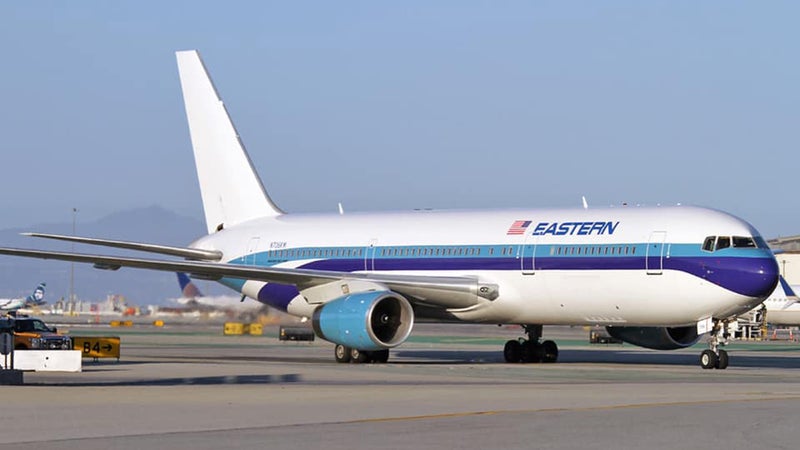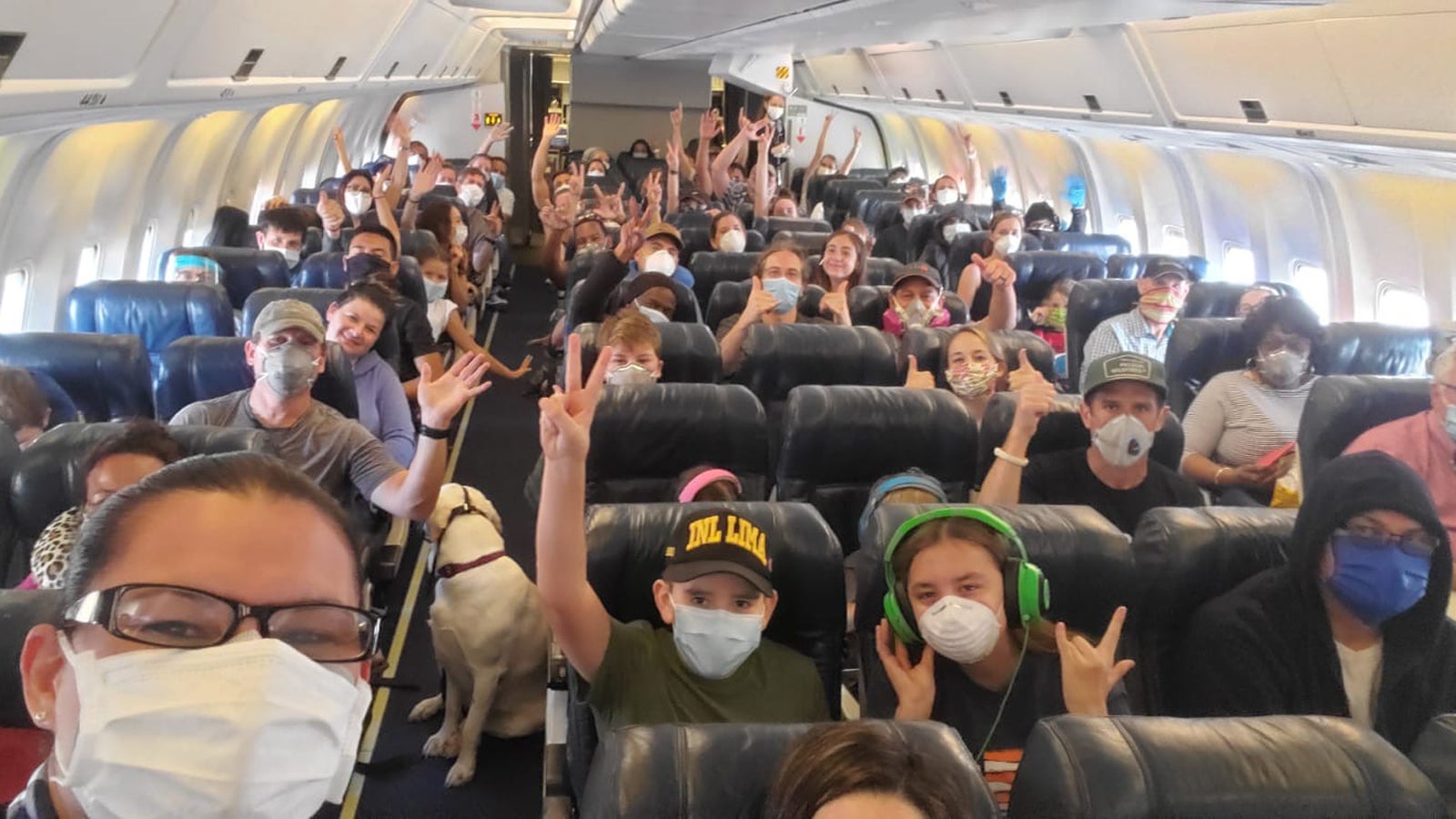When returned to the skies in January, the newly revived brand didnÔÇÖt know╠řthat a global pandemic would soon halt nearly all air travel around the world. Yet while COVID-19 has grounded most flights from major airlines, Eastern has found a way to keep busy, working in partnership with the State Department to help bring╠řstranded U.S. citizens╠řhome from╠řCentral and South America.╠ř
For those who remember, the name Eastern Air Lines (formerly spelled as such) sparks╠řmemories of the golden age of air travel. A prominent player for most of the 20th century, the Miami-based airline╠řhit its peak in the 1950s before bankruptcy grounded its fleet in 1991. An initial╠ř, in 2015, was short-lived, but in╠řJanuary, Eastern returned with a flight from Guayaquil, Ecuador, to New York City, along with a whole new for the 21st century. The airline planned to introduce its next flight, from New York City╠řto Georgetown, Guyana, in mid-March, and another route to Cabo San Lucas, Mexico, later this year.╠ř

Then the pandemic hit, and Eastern had to re-strategize. As airports around the world began to close, thousands of American tourists became . The State Department reached out to Eastern to help get citizens home from Guyana after the airline successfully flew╠řcharters╠řto return medical students based in Grenada and Panama City to the U.S. in early March.╠řThe airline then started╠řa repatriation flight from Georgetown to Miami╠řon March 13. This came just as the State Department launched a on March 19, ordering a plan for╠řgovernment-funded charter flights╠řto╠řbe╠řconducted by commercial airlines. Repatriated passengers would╠řbe expected to╠řeventually ╠řupon their return.
Eastern saw an opportunity. Unlike that are repatriation flights and determining fares based on an agreement╠řwith╠řthe federal╠řgovernment, Eastern╠řsets its╠řown fares and only works with the╠řgovernment to determine how many passengers to expect on each flight. Its repatriation flights cost up to $2,000 one-way, which CEO Steve Harfst╠řsays is because the airline flies the planes from the U.S. empty, so passengers are essentially paying for a round-trip ticket. The cost is relatively comparable to╠řother airlines, with examples that include a $1,000 United from Lima, Peru, to Houston, and nearly $1,500 from Marrakech, Morocco, to any of ten╠řU.S. cities via various airlines, according to .╠ř
Since EasternÔÇÖs╠řinaugural flight, it has returned╠ř17,013 passengers╠řon 102 flights from 15 countries across Central and South America, including Peru, Argentina, and Nicaragua. It has╠řalso flown 3,412 non-American travelers from the U.S. to their home countries.╠řOn average, repatriation flights have been 68 percent full, and the airline hasnÔÇÖt turned a significant profit. ÔÇťOn some of the flights, weÔÇÖve lost money. Some of the flights, we havenÔÇÖt. On average╠řweÔÇÖre probably just barely above breakeven,ÔÇŁ Harfst says. ÔÇťWe make a commitment to fly the flight, so weÔÇÖre somewhat taking a risk and believing that the U.S. embassy is being real with the numbers [of passengers] that they expect. But if 30 people showed up, weÔÇÖd still fly the plane.ÔÇŁ╠ř
Coming from a fledgling airline with fewer than 200 employees, this initiative is surprising. Before the pandemic, Eastern was banking on business from a specific demographic: adventurous millennials. Calling itself the ÔÇťexplorer brand,ÔÇŁ it hoped that a combination of budget fares to underserved adventure locales, a liberal baggage policy (one bag of up to 70 pounds free of charge), and smart marketing would win over a generation that prides itself on spending money on experiences, not stuff. EasternÔÇÖs 2018 internal study deemed Guayaquil, Georgetown, and Cabo San Lucas up-and-coming South American adventure destinations.
ÔÇťWe make a commitment to fly the flight, so weÔÇÖre somewhat taking a risk and believing that the U.S. embassy is being real with the numbers [of passengers] that they expect,ÔÇŁ╠řHarfst says.
But some werenÔÇÖt so convinced that the approach of tapping into such a specific market would work. ÔÇťIt could be tough to sustain a business with such a narrow focus,ÔÇŁ says Lori Ranson, a senior analyst at the Sydney-based . She points to Air FranceÔÇÖs attempt in 2017 to target younger travelers with its now defunct subsidiary,╠ř,╠řthrough things like budget fares, colorful seats, and casual flight-attendant attire.╠řHowever, Harfst says these are ÔÇťairline frillsÔÇŁ╠řthat donÔÇÖt add value to a travelerÔÇÖs experience, adding that Eastern wants to provide ÔÇťhassle-free serviceÔÇŁ╠řfor its passengers.
In February, before the pandemic hit, Harfst told ║┌┴¤│ď╣¤═° that he anticipated EasternÔÇÖs flights would be 50 to 70 percent less expensive than other airlines, citing cost-cutting measures like operating wide-body aircraft that allow for more seating and luggage. (JetBlue does not have wide-body aircraft, though other airlines, like American and United, do.) The company also owns its fleet. (According to a 2018 ╠řby the Centre for Aviation, half of the worldÔÇÖs commercial planes are leased.)╠řRanson noted that the companyÔÇÖs spending costs would need to be ÔÇťwell below its competitorsÔÇŁ in order to meet its proposed fares.╠řBut over the course of February and early March, EasternÔÇÖs fares were comparable with its╠řcompetition.╠ř
When we contacted Harfst╠řagain this month and asked if those╠řcheaper fares would still be possible following the pandemic, Harfst says he didnÔÇÖt know, though he expects all airline fares to increase after a complete return to travel. While there may be initial deals to attract fliers back, airlines will eventually have to make up for lost revenue. ÔÇťThe costs [of flying] donÔÇÖt change,ÔÇŁ he says. ÔÇťItÔÇÖs╠řfair to assume that, regardless of what does happen, fares are going to be more expensive.ÔÇŁ╠ř
As for the future, Harfst believes that Eastern could come out ahead of other airlines post-pandemic. As a small business, it received support from the CARES Act, but Harfst says its low-cost structure makes the company more resilient. He notes that as a startup company with fewerÔÇöand newerÔÇöemployees, it doesnÔÇÖt have to cover the higher compensation of tenured members (though he adds that Eastern pays its employees a competitive wage). In addition to lower labor costs and the fact that it owns its own planes, Harfst says╠řthe shrinking travel industry will result in more underserved markets, allowing for Eastern to pursue its original business model. ÔÇťWe think that thereÔÇÖll be domestic opportunities that will be open to us, as routes and markets are either abandoned or left with less capacity,ÔÇŁ he says, citing the airlineÔÇÖs╠řrecent application for a domestic nonstop flight from New York to San Diego. ÔÇťThere are still people all around the world who will need to or want to travel that now wonÔÇÖt╠řhave that opportunityÔÇöor if they do, itÔÇÖs a two- or three-stop flight. Those small markets are still very attractive to a company like Eastern.ÔÇŁ


